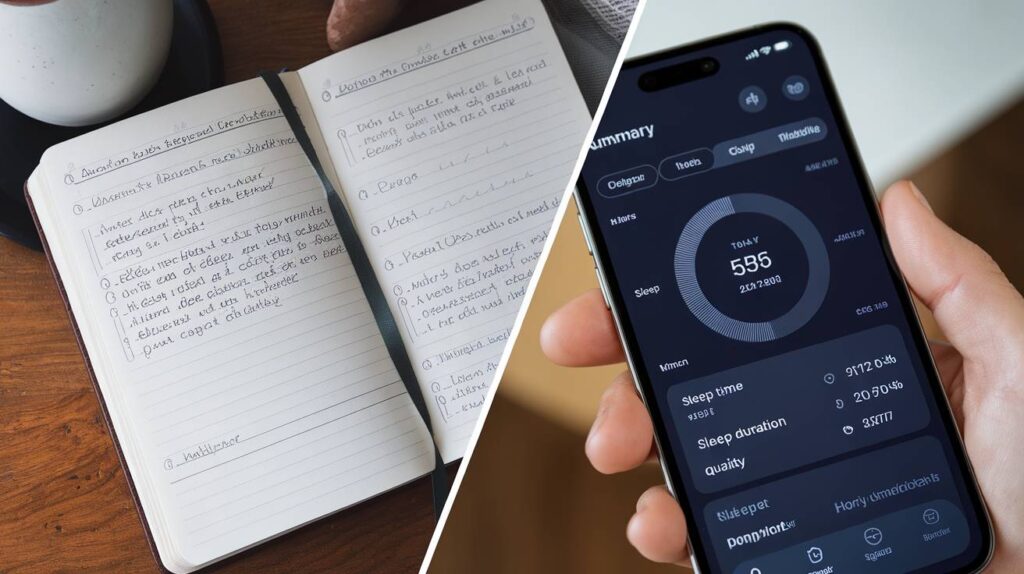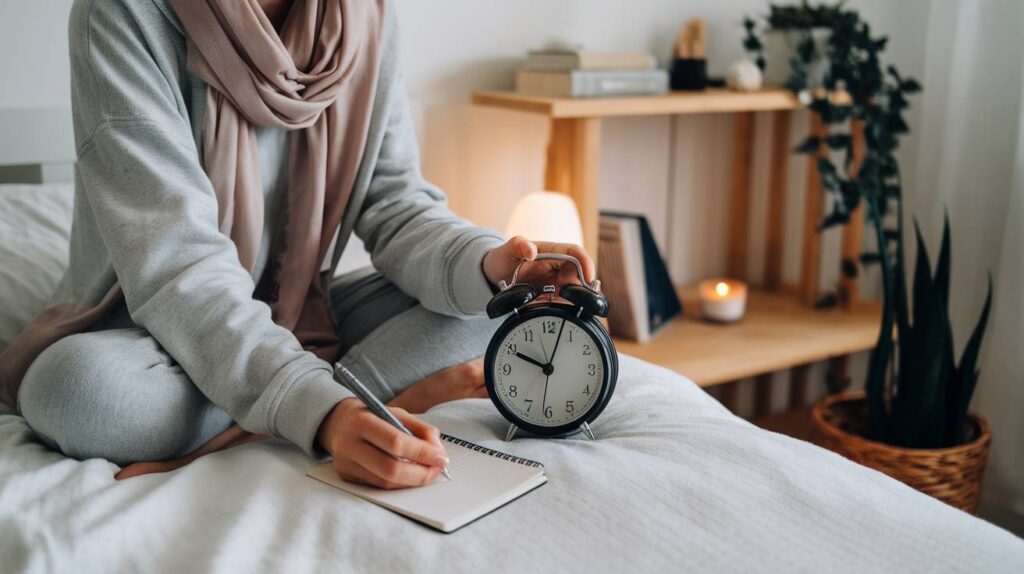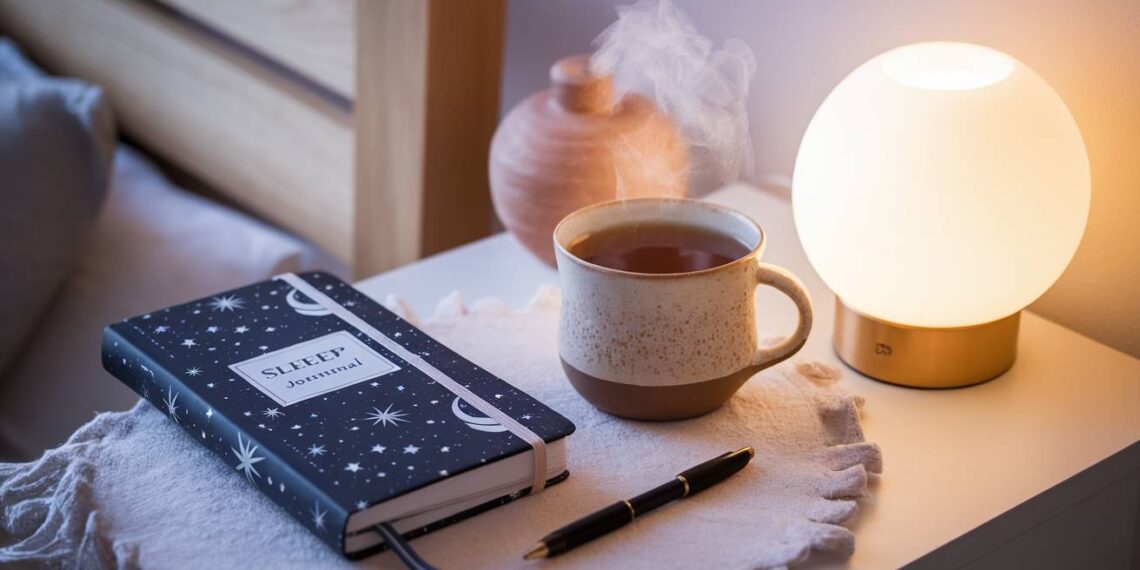Struggling to get a good night’s sleep? You’re not alone. In our hectic world, quality rest is often elusive, leaving many of us feeling drained and unfocused. If tossing and turning has become your nightly ritual, it might be time to take a closer look at your sleep habits. Sleep journals are powerful tools that can help you uncover the secrets to better sleep by tracking patterns, identifying issues, and implementing effective changes.
By recording your sleep experiences, mood, and daily activities, you gain valuable insights into what’s affecting your rest and how to improve it. Let’s explore the importance of sleep journals, discover who can benefit from them, and learn how to choose the best one for your needs.
Key Takeaways
- Understand Your Sleep Patterns: Sleep journals help identify factors that impact your sleep quality, such as lifestyle habits, stress, and environmental conditions.
- Tailored for Everyone: From busy professionals to students, parents, and wellness enthusiasts, sleep journals cater to various lifestyles and sleep challenges.
- Choose the Right Type: Select from traditional pen-and-paper journals, digital apps, or customizable planners based on your preferences.
- Essential Features to Look For: Opt for sleep journals that offer comprehensive tracking capabilities, mood and energy level recordings, goal-setting sections, and encourage consistency.
- Effective Journaling Tips: Set realistic sleep goals, track your progress, learn from patterns, and prioritize self-care to enhance sleep quality.
Importance of Sleep Journals
You know, sleep journals can really change the way you hit the hay! They help folks figure out what’s helping or hindering their snooze time, paving the way for nights filled with sweet, uninterrupted dreams. By scribbling down what goes on before bedtime, such as late-night snacks or peeking at social media, people can wake up feeling as radiant as a morning sunflower.
“Your future depends on your dreams, so go to sleep.” – Mesut Barzani
Getting the Lowdown on Sleep Patterns
You get more than just a few zzz’s with a sleep diary. It’s like holding a magnifying glass to the hours you spend dozing, showing you not just how much sleep you’re getting, but what’s messing with your rest. Maybe it’s that afternoon coffee or a late-night TV binge. Check out what you can unravel with this little habit:
| Eye-opener | Details |
|---|---|
| Knowing Yourself | Spot what’s getting in the way of sweet dreams. |
| Stepping Up | Push yourself to stick to a sleep regime. |
| Finding Fixes | Zero in on culprits keeping you from dreamland. |
| Smashing Sleep Goals | Track how your sleeping habits evolve over time. |
Tuning into your own sleep behavior can spark smart swaps in your nightly routine.

Boosting Bedtime Bliss
Sleep journals help make dreams come true—literally! Jotting down sleep timings and nighttime shenanigans on the reg can reveal areas patterns like magic. It’s like being your own sleep detective. Here’s how a diary can sprinkle some magic dust on your rest:
- Spotting the Signs: Make a habit of tracking, and soon you’ll notice the habits and hobgoblins that either cuddle you to sleep or keep you wide-eyed.
- Nailing Down Timeframes: Maybe you’re shooting to slide under the sheets by 10 PM. Writing it down helps keep that internal alarm clock ticking right.
- Review & Reflect: Flipping back through notes lets you weed out what doesn’t work and keep what does. Discover, through trial and error, your golden sleep routine. Check our evening routine checklists.
- Relaxation Hacks: Experiment with things like gadget-free evenings or sipping on herbal teas. Mark it down, see what sticks, and sleep like a baby!
When you make friends with a sleep journal, peace in dreamland doesn’t seem so far-fetched. Toss those sleepless nights away, and peek at our sleep journal template to start tallying your ticks and tocks.
Target Audience Overview
Getting to know who’s using sleep journals helps open our eyes to how they can really change sleep habits for all types of folks. We break it down here by the folks who’d really get the most out of the best sleep journals.
Working Professionals with Crazy Hours
For those stuck in high-pressure jobs, weird hours can mean sleep all over the place. A sleep journal can help these folks figure out what’s going on with their sleep, spot problems, and make tweaks to their routine that might actually help them get some shut-eye. They might also see how their work life is messing with sleep, which could help them get a handle on their health.
| What’s Keeping Them Up | What a Journal Can Do |
|---|---|
| Night shifts or crack-of-dawn starts | Spot the best times to hit the hay |
| Erratic sleep lengths | Check out patterns and fix ’em if needed |
| Working through the night | Discover tricks for better rest |
Parents Trying to Nail Down Family Sleep Schedules
Parents are always juggling a million things, and it’s no surprise if sleep takes a hit—both for them and the kiddos. Sleep journals let parents track not only their own zzz’s but also how well the kids are sleeping. This can help them figure out routines that get the whole family sleeping better.
| Family Sleep Needs | Journal Perks |
|---|---|
| Getting the kids to bed | Set up sweet bedtime habits for the little ones |
| Shared bedrooms | Pinpoint what’s keeping everyone up and fix it |
| Making health tweaks | See how changing up the routine helps sleep |
Students Balancing Books and Bedtime
Students often face-off with fitting in study time and enough sleep, which can lead to rough nights. With a sleep journal, they get to look back at how their study habits are messing with their sleep. This can nudge them into making sleep a bigger deal in their routine.
| Student Sleep Struggles | What Comes from Journaling |
|---|---|
| Burning the midnight oil | Shape a better bedtime game plan |
| Exam cramming | Keep tabs on lost zzz’s and how to bounce back |
| Partying or hanging out | Find that sweet spot between fun and sleep |
Shift Workers Needing to Adjust on the Fly
Shift workers have it rough when it comes to sleep since they’re always changing gears. Sleep journals give them a hand in piecing together environments and routines that keep them rested, even if they’re sleeping at wacky times.
| Shift Work Challenges | Journal Advantages |
|---|---|
| Hectic hours | Tweak sleep habits for each shift |
| Snoozing during the day | Check on how power naps are doing the job |
| Fast bounce-back needs | See how well they’re resting after shifts |
Wellness Buffs Craving Quality Snooze
Those who are all about staying healthy often look for ways to up their sleep game. Sleep journals help them figure out what good sleep practices really do for them, noting how things like diet, workouts, and even what they’re feeling play into sleep.
| Healthy Goals | Journal Rewards |
|---|---|
| Better sleep vibes | Sync up diet details and shut-eye |
| Chill-out tactics | Pin down what pre-sleep magic actually works |
| Life in balance | Watch how lifestyle shakes sleep up |
Everyone’s got their own spin on how they can use a sleep journal to get better rest. If you’re curious to dig into more, there’s stuff on crafting a morning routine for better sleep and bedtime routines that stick that could be super helpful.

Types of Sleep Journals
Tracking your sleep can be easier with the right sleep journal. Whether you’re a paper lover, a tech enthusiast, or someone who likes to mix and match, there’s something for you. Let’s break it down into three categories: good ol’ pen and paper, slick digital apps, and those fancy customizable planners.
“Sleep is the golden chain that ties health and our bodies together.” – Thomas Dekker
Traditional Pen and Paper Journals
Let’s start with the classic route. A traditional sleep journal with pen and paper is like a comfy sweater for your thoughts. It’s low-tech and lets you focus on what’s important without your phone buzzing every two seconds.
| Feature | Advantages |
|---|---|
| Simplicity | No confusing gadgets, just grab and write |
| Reflection | Helps you be mindful and intentional |
| No Distractions | Zero pesky notifications or tech hiccups |
These journals usually have spots for scribbling down how long you slept, how well you slept, and any nighttime surprises (hello, barking dog). They can also let you track your mood, energy, and daily shenanigans. Perfect if you’re a parent wrangling bedtime or a student balancing books and naps. Wanna set up a bedtime routine? Check out our tips here.
Digital Sleep Tracking Apps
For the gadget geeks out there, digital apps are a dream. These whiz-bang tools bring sleep tracking into the 21st century with bells and whistles galore. Many come with easy-to-navigate screens and colorful graphs that do all the math for you.
| Feature | Advantages |
|---|---|
| Data Analysis | Spot trends and patterns over time |
| Custom Reminders | Wake-up and wind-down alerts at your fingertips |
| Integration | Hook up with other health apps for a lifestyle overhaul |
These apps can keep tabs on how deep you’re snoozing and even let you track what you ate or if you hit the gym. Handy for fitness junkies trying to get those perfect Zs. For a deep dive into timing your workouts for better sleep, see our article here.

Customizable Sleep Planners
If you’re all about blending the best of both worlds, customizable planners are the way to go. They offer pre-set templates but let you tweak things to fit like a glove.
| Feature | Advantages |
|---|---|
| Flexibility | Adapt the layout to whatever floats your boat |
| Goal-Oriented | Sections to dream big (pun intended) and track progress |
| Comprehensive | Tie your sleep schedule with overall wellness goals |
These planners can get deep into your hopes, dreams, and sleep patterns, keeping your motivation in check. They let you see where you stand consistently and encourage keeping on track. Need help staying accountable? We’ve got resources for tracking progress here.
Each type of sleep journal brings its own flavor to the table, matching different preferences and lifestyles. So, find the one that fits you like a pillow and catch those precious Zs.
Features to Look For
Snagging the right sleep journal can be like finding that perfect pillow; it’s all about what clicks for you. There are certain standout features that not only spice up the journaling fun but also sneakily boost your zzz’s. Here’s the lowdown on what makes a journal a real nighttime MVP.
Sleep Tracking Capabilities
First things first, a solid sleep journal should be your trusty sidekick in tracking your sleep. This isn’t just about logging when you hit the hay and when you drag yourself out of bed. It’s about spotting patterns that can clue you into tweaks for better snoozing.
| What to Track | Why It Matters |
|---|---|
| Hours Slept | Keep tabs on your nightly total. |
| Sleep Quality | Judge how deep and restful your sleep is. |
| Fall Asleep Time | Record how quick you zonk out. |
| Night Awakenings | Jot down any tosses and turns. |
Mood and Energy Levels Tracking
Mood swings and energy dips throughout the day aren’t just random. A journal that lets you jot down these vibes helps draw lines between your shut-eye patterns and how sprightly you feel. Great for families too, as this can help tailor daily routines that sync beautifully with sleep patterns.
| Time Slot | Mood | Energy |
|---|---|---|
| Morning | Happy/Anxious | Raring to go/Dragging feet |
| Afternoon | Motivated/Sleepy | Middling/Fading fast |
| Evening | Chill/Stressed | Buzzing/Running on fumes |
Goal Setting and Reflection Sections
Your sleep journal should do more than spit back numbers; it’s like having a sleep coach inside a notebook. Having a spot for setting goals and reflecting is key. Whether you’re targeting sleep consistency or quality, these sections let you map out your dreams for better nights and pat yourself on the back when you hit milestones.
| Goal Type | Target | How It Went |
|---|---|---|
| Keep it Regular | In bed by 10 PM | Less groggy after a week! |
| Sleep Soundly | Cut nighttime wake-ups | Solid sleep 4 nights out of 7. |
Importance of Consistency in Recording
Let’s face it, a journal is only as good as the stuff you scribble down. Regular entries mean you’re keeping an eagle-eye on your sleep, making it way easier to tweak things and see what’s up. Get a journal that’s a breeze to fill out; maybe it nudges you with reminders or fits snugly into your nightstand routine.
| How to Stick With It | Why Do it |
|---|---|
| Set a Daily Alarm | Dedicate time every night for an update. |
| Keep it Handy | Store it on your nightstand. |
| Jazz it Up | Use fun pens or stickers to keep it interesting. |
By keeping these nifty features in mind, you’ll have a journal that’s like a backstage pass to better sleep habits. Hunting for more tips to boost your night routine game? Check out our reads on how to create a bedtime routine and evening routine checklist.
Adding Sleep Journals into Your Day
Getting a better night’s sleep is a real game-changer, and starting a sleep journal is a down-to-earth way to help make it happen. This little book lets you spot your sleep patterns and tweak what doesn’t work.
Start a Journaling Habit You Can Stick To
The trick with journaling is to keep it regular, like clockwork. Pick a spot in your daily routine to jot down notes, like right before bed or as you sip your morning coffee. This way, it becomes part of what you do naturally.
| Time of Day | Activity |
|---|---|
| Evening | Jot down thoughts about the day, your sleep routine, and how you wind down. |
| Morning | Note how well you slept and how peppy you feel when you wake up. |
Making journaling part of habits you’ve already got, like your nightly wind-down or your morning start-up, can make it second nature. Curious about setting up a routine? Hit up our piece on how to create bedtime routine for some handy tips.
Use Journal Notes to Boost Your Sleep
Your sleep journal is more than a diary—it’s a goldmine of info about how stuff like your mood and energy levels link to your sleep. When you read back over your notes, you might spot patterns that mess with your snooze.
| Data Points | Description |
|---|---|
| Sleep Duration | How long you slept each night. |
| Sleep Quality | Rate last night’s Zs from 1 to 10. |
| Energy Levels | Chart your get-up-and-go during the day from 1 to 10. |
Spotting what drags down your sleep can guide you in making the right changes. Maybe it’s the late-day espresso shot or staying up with a million things—now you know! Want more info on keeping a sleep schedule? Check benefits of a consistent sleep schedule.
Keep the Journal Habit Alive
Share what you find in your sleep journal with friends or family—it can help keep you on track. Cluing into a wellness crew that shares your sleep goals is another win-win for support.
Set yourself some goals to keep the journal working for you. Maybe aim for hitting the sack at the same time every day or celebrate when your bed-to-bed stats look good.
Check out our tips for making it all come together in our article on sunday routine for sleep. By welcoming a sleep journal into your routine, you’re steering your sleep ship in the right direction, and it all adds up to feeling better all around.
Tips for Effective Journaling
Want to get better z’s? Journaling about your sleep might just do the trick. Here’s how to make the most of it.
Setting Realistic Sleep Goals
No one likes setting themselves up to fail. When you’re starting a sleep journal, aim for goals you can actually hit. Outlandish goals just lead to annoyance. Take stock of how you’re sleeping now, and tweak from there. Check out these goals for size:
| Goal Type | Example Goal |
|---|---|
| Total Sleep Duration | Shoot for 7-8 hours of snooze time each night |
| Consistent Sleep Schedule | Die-hard bedtime fan? Try a 30-minute buffer zone, hit the hay, and rise at the same time daily |
| Pre-Sleep Relaxation | Spend 15 chill minutes before lights out |

Tracking Progress and Adjusting Accordingly
Jot down your sleep details in the journal: when you hit the pillow, when you roll out of bed, and how well (or not) you slept. Over time, you’ll spot patterns that help tweak your rest for the better. Your notes could look like this:
| Date | Bedtime | Wake-up Time | Sleep Quality (1-10) | Notes |
|---|---|---|---|---|
| 01/01/2023 | 10:30 PM | 6:30 AM | 8 | Woke up feeling on top of the world |
| 01/02/2023 | 11:00 PM | 7:00 AM | 6 | Ugh, woke up twice and then some |
Learning from Patterns and Trends
Keep an eye on your journal entries, and you might find out that crawling into bed earlier or cutting down on screen time actually boosts your sleep quality. Use this eye-opener to tweak your habits. Maybe focus on:
- Keeping bedtime steady
- Evening rituals
- What you’re up to before bed
Prioritizing Self-Care and Relaxation Techniques
Relax before bed, and you’re more likely to drift off peacefully. So get in the groove of some kind of self-care. Could be simple stuff like:
- Thumbing through a book
- Trying out meditation
- Stretching with some gentle yoga
Keep track of these chill-out sessions in your journal to see what works. Need more ideas? Check out our piece on screen-free bedtime activities.
By rolling with these tips, your journaling practice can morph into a full-on sleep enhancement strategy. And if you like things laid out for you, we’ve got a sleep journal template that cuts out the guesswork.
Tips for Effective Sleep Journaling
- Be Consistent: Make entries at the same time each day to ensure accuracy.
- Record Details: Note not just sleep times but also factors like caffeine intake, exercise, stress levels, and screen time.
- Set Achievable Goals: Start with small, realistic sleep improvements to build momentum.
- Reflect Regularly: Review your journal weekly to identify patterns and make necessary adjustments.
- Combine with Relaxation Techniques: Integrate activities like meditation or reading to enhance sleep quality.
Conclusion
Achieving better sleep doesn’t have to remain a dream. By incorporating a sleep journal into your daily routine, you can unlock the mysteries of your sleep patterns and make informed changes to enhance your rest. Whether you’re juggling a demanding job, balancing studies and sleep, or managing a busy household, a sleep journal can be your ally in the quest for rejuvenating sleep. Consistency is key—by diligently recording your sleep habits and reflecting on the data, you pave the way to nights of sound sleep and days filled with energy and focus. Embrace this journey toward better sleep—one journal entry at a time—and experience the transformative power of restful nights.
FAQs
What is a sleep journal, and how does it work?
A sleep journal is a tool used to record information about your sleep patterns, habits, and factors that may affect your sleep. By consistently noting details like bedtime, wake time, sleep quality, mood, and daily activities, you can identify trends and triggers that impact your rest, allowing you to make informed adjustments to improve sleep.
Who can benefit from using a sleep journal?
Sleep journals are beneficial for anyone looking to improve their sleep quality. They are particularly useful for individuals with irregular schedules like shift workers, students balancing academics and rest, parents managing family routines, and wellness enthusiasts aiming to optimize their health.
What features should I look for in a sleep journal?
Look for sleep journals that offer comprehensive tracking capabilities, sections for recording mood and energy levels, goal-setting and reflection prompts, and encourage consistency. Depending on your preference, you might choose between traditional pen-and-paper journals, digital apps, or customizable planners.
How can I make journaling a consistent habit?
Incorporate journaling into your daily routine by setting a specific time for entries, such as before bed or after waking up. Keep your journal easily accessible on your nightstand or set reminders if you’re using a digital app. Consistency enhances the effectiveness of the journal in identifying patterns and improving sleep.
What tips can enhance the effectiveness of my sleep journal?
Set realistic sleep goals, regularly review your journal to identify patterns, adjust your habits accordingly, and prioritize self-care practices like relaxation techniques before bed. This proactive approach can significantly improve your sleep quality over time.
Resources
- National Sleep Foundation – How to Keep a Sleep Diary
- Healthline – Best Sleep Apps of 2023
- Mayo Clinic – Sleep Tips: 7 Steps to Better Sleep






